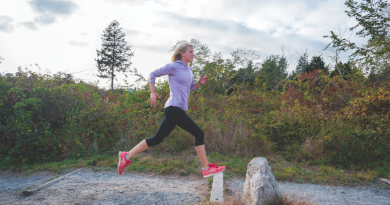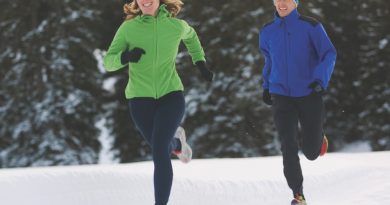5 most common running injuries that can be helped with the right pair of shoes
By Christy Lynn
Remember that old children’s song about the foot-bone that’s connected to the shin bone and the shin bone that’s connected to the knee bone and the knee bone that’s connected to the hip bone? Well, turns out that anatomy lesson was pretty much on target and, at least for runners, it all starts with the first point of contact, the foot hitting the road.
How the foot strikes the ground when running and how much flex there is in the foot and arch affects the movements of the shin, knee, femur, hip, lower back and even neck.
Not all of us runners have perfect biomechanics naturally (in fact, less than 10 percent of runners do), which means we rely on support from footwear. The good news is that most run footwear companies have biomechanical experts on staff that spend their days designing shoes that correct extraneous movement in the feet which help align people with all types of gaits and natural biomechanics into the proper positioning.
Five of the most common running injuries can be at least partially linked to misalignment of the body, and similarly can be relieved with proper attention to your unique biomechanics and the shoes you wear to assist it.
Here’s a run-down of those injuries and solutions to the problem:
Plantar Fasciitis — Refers to the inflammation of the plantar fascia, a thick band of connective tissue that connects the calcaneous (bone) of the heel to the base of the toes. The tissue is like a rubber band and can be overstretched between the two points. Pain is typically felt in the heel and is often worst in the mornings when it is tightest. Can be caused by overuse or improper support through the arch of the foot. Relief: The easy answer is to add support to the arch and relieve the over-stretched tension created in that ligament. This can be achieved with orthotics or insoles added to shoes to increase contact through the center of the foot, or simply by ensuring you are wearing shoes with the proper amount of built-in stability.
Achilles Tendonitis — Similar to plantar fasciitis, Achilles tendonitis refers to an inflammation or tear in the Achilles tendon, which connects the back of the calcaneous bone of the heel and the calf muscle. Problems often result from tightness of the calf, which cause undue strain on the tendon. Pain is most often felt at the connection point to the heel, which can become incapacitating if swelling and inflammation set in. Relief: Temporary relief can come from raising the height of the heel to lessen the strain on the Achilles tendon. Heel lifts and/or orthotics can be added to shoes. Consider avoiding minimalist shoes or shoes with a very low heel-toe drop if you have this injury, as such footwear will increase the stretch of the Achilles tendon and aggravate the problem (average is 10-12mm, minimalist shoes are between 0 and 4mm drop). Icing, resting and stretching will also help relieve symptoms.
IT Band Syndrome — The Iliotibial Band is a thick connective fascia that wraps around the outside of the knee and runs to the outside of the hip. Inflammation and pain can be felt anywhere along the tract, but is most common at the connective points—on the knee or in the butt and hips. Noticing a pattern? When this band is stretched or strained out of its proper biomechanical alignment, you’ll see a problem. Relief: Massage, ice and stretching will help loosen strain in the IT Band. Foam rollers work wonders for this injury, despite the discomfort during the rolling. If you run on a cambered road, make sure you aren’t always running in one direction (people who run a loop on an uneven road will often suffer this injury on the left leg, or the one that is always downhill). Again, ensure you have the proper support in your footwear, as wearing shoes that allow your foot to pronate will cause your whole leg to fall out of alignment, therefore stressing all of these connective tissues and ligaments.
Runners’ Knee — Clinically known as patellofemoral knee syndrome, this injury refers to pain in the area underneath the kneecap where the joint connects the patella (knee cap) to the femur (thigh bone). Pain can be acute or chronic and worsens with use. Relief: Rest and ice are the best relief for runners’ knee, especially for immediate relief. Biomechanical misalignment can be the root cause of knee trouble and can sometimes be corrected with properly supportive shoes, orthotics, or a change in running technique and form. Heavy heel striking can exaggerate pressure on joints, thereby aggravating the problem, so it may be time to examine your gait and soften your stride.
Shin Splints — Medial Tibial Stress Syndrome, popularly known as shin splints, is one of the most common injuries, especially for athletes rapidly increasing their training. There are two kinds of common shin pain: on the outside of the shin (lateral) and on the inside of the shin (medial). Lateral pain typically relates to overtraining and can be relieved by rest and ice; this pain is clinically not considered shin splint. Medial shin splints are characterized by burning or sharp pain on the inside of the shinbone (tibia) and effect the connective tissue and muscles as well as the bone itself. In extreme cases, shin splints can lead to stress fractures in the tibia, which is extremely painful and can require a much longer recovery. Relief: Medial shin splints also benefit from rest and icing to bring down swelling. (No magic bullets here, just take it easy.) Over-pronation of the feet is also a risk factor for developing shin splints, as inward rotation of the foot and angle pull the muscles on the inner shin away from the tibia bone, adding stress to that high-impact area. Overly worn shoes can also aggravate the problem, as decreased cushioning means the shoes are not absorbing as much of the shock, which is therefore transferred to the bones and joints of the feet and lower legs. New shoes might be a consideration.
As with all sports-related injuries, check with a physical trainer or medical professionals if problems persist.
Editor’s note: Christy Lynn spent two years working in specialty running stores in New York City and Vancouver, B.C. before joining a specialty running company as a technical representative. She then became a biomechanics guru, traveling across western Canada educating runners and running shops about how footwear affects natural biomechanics and can be used to relieve and prevent some of the most common running injuries. She now works in the family publishing business, but still loves to run and in her spare time keeps tabs on all the new changes and developments in the running world.


